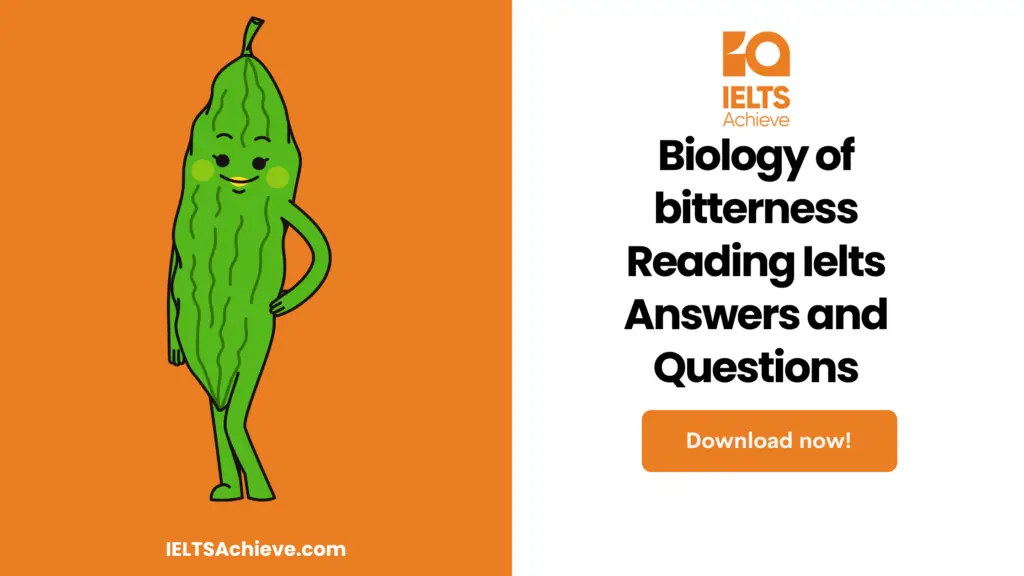The Blog post contains the following IELTS Reading Questions:
- IELTS Reading Multiple choice questions
- IELTS Reading Locating information
- IELTS Reading Summary completion

IELTS reading passage – Biology of Bitterness
Biology of Bitterness
A. Majority of individuals prefer not to drink more than a few ounces of grapefruit juice and as a result of this, it is served in small glasses. Grapefruit consists of a naturally occurring chemical compound that has a bitter taste and is named Arginin. Some are of the notion that they enjoy the bitterness in small doses as it enhances the overall flavour whereas, a few others claim that they prefer to avoid it entirely. As a result, juice packagers more often choose grapefruit with low arginine levels. Despite the fact that the compound contains antioxidants, which some nutritionists believe may aid in the prevention of cancer and atherosclerosis, the compound is not recommended for consumption.
B. Nevertheless, grapefruit without bitter taste has possible benefits. In a test- Linguagen Corporation which I eventually decided to take part is a biotechnology firm in Cranbury, New Jersey. Sets of two miniature white paper cups labelled 304 and 305 were given to a few people seated around a conference table. We drank from one cup, then the other, wiping our palates with water and a soda cracker in between, blocks the bitterness in foods. However, comparatively, 305 was smoother; it didn’t have the bitterness of arginine but a sour citrus flavor. Additives in the juice were added such as adenosine monophosphate or AMP; it is mainly used to deduce the nutritional value.
C. Five primary flavors are delved into by scientists namely – .sweet, sour, bitter, salty, and umami, the savory taste of protein these days. Bitterness is untapped potential in food and as a result, it is appealing to the industry. Nature contains thousands of bitter-tasting compounds. Their main work is to protect the poisonous plant from animals and vice versa. However, the system is not without flaws. Despite the fact that sometimes as a result of their bitter taste, grapefruit, and cruciferous vegetables like Brussels sprouts and kale are nutritious. As time passes, the majority of individuals have learned to love them, at least in small doses.Charles Zuker, a neuroscientist at the University of California, San Diego, asserts that only humans enjoy bitter flavors. Every other species dislikes bitter because it implies bad news, but humans have learned to enjoy it. We consume both coffee and quinine. Because bitterness can be palatable in small doses but repulsive in large doses, we believe that AMP could make a variety of foods, drinks, and medicines more appetizing — and thus more lucrative.
D. Individuals differ in their ability to taste bitterness, and these differences appear to be genetic. 75% of individuals are sensitive to the bitter compounds phenylthiocarbamide and 6-n-propylthiouracil, compared to 25% who are not. According to University of Utah geneticist Stephen Wooding, those who are sensitive to phenylthiocarbamide appear to consume cruciferous vegetables less frequently than others. Some people, known as supertasters, are particularly sensitive to 6-n-propylthiouracil due to their unusually large number of taste buds. Vegetables, coffee, and dark chocolate are examples of bitter foods that supertasters typically avoid. Consequently, they may be thin. Alcoholic beverages, which are frequently slightly bitter, also repel them. For instance, the majority of people consider Dewar’s scotch to be slightly sweet. Valerie Duffy, associate professor of dietetics at the University of Connecticut at Storrs, explains, “A supertaster, on the other hand, tastes nothing but bitterness.”
E .According to a recent study, supertasters consume alcoholic beverages on average two to three times per week, whereas non-tasters consume them five or six times per week. Each onion-shaped taste bud is composed of 50 to 100 elongated cells that extend from top to bottom. Taste molecules in food and drink, known as tastants, are captured by a small cluster of receptors at the top. The receptors function similarly to those for vision and smell. When a bitter signal is received, it is transmitted via proteins known as G proteins. Robert Margolskee, the founder of Linguagen, discovered in the early 1990s at Mount Sinai School of Medicine in New York City the G protein involved in the perception of bitterness, sweetness, and umami. The protein gustducin initiates a series of chemical reactions that alter the ion concentrations within the cell. The brain finally receives a signal indicating bitterness. Margolskee describes the signalling system as “like a bucket brigade. “It traverses the G protein and reaches other proteins.”
F. In the year 2000, Zuker and his colleagues discovered 30 distinct bitter-taste receptor-coding genes. “Because the universe of bitter tastants is so vast, we knew it had to be a large number,” says Zuker. Bitter tastes the same regardless of the tastant that enters the mouth or the receptor to which it binds. The only distinction is that it is stronger and can be flavoured through the sense of smell. “Taste cells are similar to light switches,” explains Zuker. They are either active or inactive. G.Once scientists determined the location of the taste mechanism, they began to consider ways to interfere with it. They examined AMP, an organic compound found in breast milk, in addition to other substances produced by cells during digestion. Margolskee and his colleagues discovered that although amp has no bitter taste on its own, it binds to bitter-taste receptors when added to foods. Due to the fact that AMP is unlikely to bind to all 30 bitter-taste receptors, it may not be able to mask every bitter flavour. Consequently, language has increased its search for additional bitter blockers by employing high-throughput screening technology. Beginning with cultured cells, researchers stimulate bitter taste receptors. The scientists then drop candidate substances from chemical compound libraries onto the receptors and look for evidence of a reaction.
H. According to some taste researchers, compounds such as AMP will eventually make processed foods healthier. Consider that a single cup of Campbell’s chicken noodle soup contains 850 milligrammes of sodium chloride, or table salt, which is more than a third of the RDA. The salt masks the bitterness caused by the reaction between sugars and amino acids at high temperatures during the canning process. Potassium chloride, which is frequently deficient in the diets of some individuals, could be substituted for a portion of the salt. A dose of AMP can eliminate potassium chloride’s bitter aftertaste. Bitter blockers could also be used to reduce the bitterness of antihistamines, antibiotics, certain HIV drugs, and other medications in children’s cough syrup in place of cherry or grape flavouring.
I. AMP is already used in a variety of food products, and rival companies such as Senomyx in La Jolla, California, are developing additional bitter blockers. Possibly, once food companies have eliminated bitterness from canned soups and TV dinners, they will be able to concentrate on something more useful: a bitter blocker in a bottle that we can sprinkle on brussels sprouts or mix into grapefruit juice.
Biology of Bitterness IELTS reading questions
Questions 1-2
Choose the correct letter, A, B, C or D. Write your answers in boxes 1-22 on your answer sheet.
1. According to this passage, what is the main feature of AMP?
A) neutralizes bitter flavors in food
B) is only found in 304 cups
C) tastes like citrus
D) chemical reaction when biscuit meets
2. What is G protein’s primary function?
A) collecting flavor molecules
B) identifying various flavor elements
C) large molecule resolution
D) sending bitter signals to the brain.
Ready to improve your performance in Multiple Choice Questions (MCQs)? Click here to access our comprehensive guide on how to tackle MCQs effectively in the IELTS Reading section.
Questions 3-10
The reading Passage has seven paragraphs A-I.
Which paragraph contains the following information?
Write the correct letter A-I, in boxes 3-10 on your answer sheet.
3. Bitterness experiment carried out
4. I investigate future applications
5. Humans and animals interpret bitterness differently.
6. The spread of bitterness within the body
7. How AMP blocks bitterness
8. Some bitterness blockers may help reduce the negative impact
9. Fruity bitterness introduced
10. Sensitivity is determined by a genetic feature.
Questions 11-14
Complete the following summary of the paragraphs of Reading Passage, using no more than two words from the Reading Passage for each answer. Write your answers in boxes 11-14 on your answer sheet. Grapefruit’s bitter taste is caused by a substance called 11._____________, which is found in it. Bitterness, on the other hand, is important in plants. It indicates that a specific plant is 12._________. Different people have different genetic abilities to taste bitterness. According to a University of Utah scientist, 13. ___________have an abundance of 14._____________, which allows them to perceive bitter compounds.
Boost your performance in Summary, Notes, Table, and Flowchart Completion tasks. Click here to explore our detailed guide and learn how to effectively complete summaries, notes, tables, and flowcharts in the IELTS Reading section.
Unlock your full potential in the IELTS Reading section – Visit our IELTS Reading Practice Question Answer page now!
Recommended Questions:
Renewable Energy IELTS Reading Question with Answer
Biology of Bitterness IELTS reading answer
1. A
2. D
3. B
4. I
5. C
6. E
7. G
8. H
9. A
10. D
11. Naringin
12. Poisonous
13. Supertasters
14. Tastebuds

We hope you found this post useful in helping you to study for the IELTS Test. If you have any questions please let us know in the comments below or on the Facebook page.
The best way to keep up to date with posts like this is to like us on Facebook, then follow us on Instagram and Pinterest. If you need help preparing for the IELTS Test, join the IELTS Achieve Academy and see how we can assist you to achieve your desired band score. We offer an essay correction service, mock exams and online courses.

